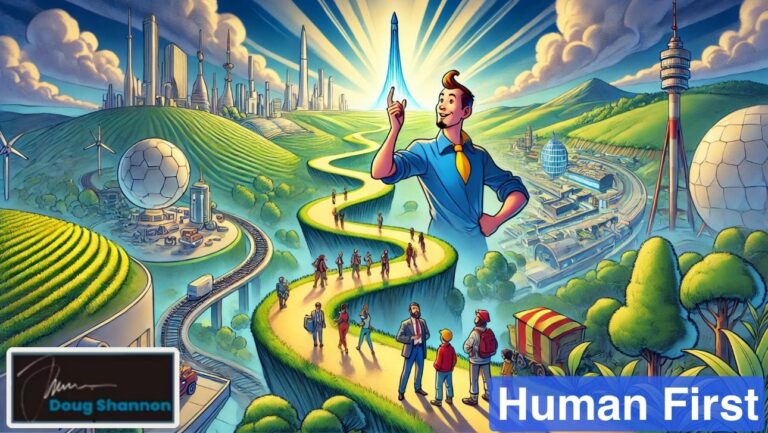𝐇𝐮𝐦𝐚𝐧-𝐅𝐢𝐫𝐬𝐭 𝐋𝐞𝐚𝐝𝐞𝐫𝐬𝐡𝐢𝐩: 𝐀𝐥𝐢𝐠𝐧𝐢𝐧𝐠 𝐈𝐧𝐧𝐨𝐯𝐚𝐭𝐢𝐨𝐧 𝐰𝐢𝐭𝐡 𝐏𝐞𝐨𝐩𝐥𝐞 𝐚𝐧𝐝 𝐏𝐮𝐫𝐩𝐨𝐬𝐞
“Human-first” means approaching innovation, AI, and enterprise transformation in a way that prioritizes people at the center of every decision.
It’s about creating systems and processes that enhance human potential, while ensuring technology serves as an enabler of trust, clarity, and empowerment. By leveraging ACT (𝐀𝐥𝐢𝐠𝐧𝐦𝐞𝐧𝐭, 𝐂𝐥𝐚𝐫𝐢𝐭𝐲, 𝐓𝐫𝐚𝐧𝐬𝐩𝐚𝐫𝐞𝐧𝐜𝐲), this approach ensures that innovation is guided by leadership principles that respect, elevate, and embolden the workforce.
𝐀𝐩𝐩𝐥𝐲𝐢𝐧𝐠 𝐭𝐡𝐞 𝐀𝐂𝐓 𝐌𝐨𝐝𝐞𝐥 𝐭𝐨 𝐚 𝐇𝐮𝐦𝐚𝐧-𝐅𝐢𝐫𝐬𝐭 𝐀𝐩𝐩𝐫𝐨𝐚𝐜𝐡:
1. 𝐀𝐥𝐢𝐠𝐧𝐦𝐞𝐧𝐭:
• Innovation must align with both individual and organizational goals.
• Ensure AI and automation integrate seamlessly with workflows, enabling employees to do their best work by focusing on higher-value, creative tasks.
• Align ethical and cultural values with technological progress to maintain trust and engagement across teams.
2. 𝐂𝐥𝐚𝐫𝐢𝐭𝐲:
• Simplify the adoption of new technologies by making processes, roles, and AI capabilities clear and accessible.
• Provide employees with clear paths for training and development, enabling them to confidently work alongside AI systems.
• Communicate the “why” behind changes, ensuring everyone understands the vision and purpose of the innovation.
3. 𝐓𝐫𝐚𝐧𝐬𝐩𝐚𝐫𝐞𝐧𝐜𝐲:
• Make AI systems explainable, visible, and accountable, building trust in their outputs and decisions.
• Foster an open culture where employees can give feedback on how technology impacts their roles.
• Create transparency in leadership, ensuring employees see how decisions about technology benefit them and the organization.
𝐄𝐧𝐚𝐛𝐥𝐞, 𝐄𝐦𝐩𝐨𝐰𝐞𝐫, 𝐄𝐦𝐛𝐨𝐥𝐝𝐞𝐧:
• 𝐄𝐧𝐚𝐛𝐥𝐞: Provide employees with the right tools, frameworks, and training to embrace AI and innovation with confidence.
• 𝐄𝐦𝐩𝐨𝐰𝐞𝐫: Let people take ownership of how technology integrates into their work, fostering creativity and innovation.
• 𝐄𝐦𝐛𝐨𝐥𝐝𝐞𝐧: Create a culture where people feel supported and inspired to take risks, explore new ideas, and challenge the status quo.
A human-first approach, guided by the ACT model, ensures that introducing new ideas, innovations, and AI systems strengthens the workforce rather than displacing it. It’s about crafting a path forward where leadership and technology serve as partners in empowering individuals and driving enterprise success.
𝗡𝗼𝘁𝗶𝗰𝗲: The views within any of my posts, are not those of my employer. 𝗟𝗶𝗸𝗲 👍 this? Feel free to reshare, repost, and join the conversation.
#humanfirst #leadership #people
Gartner Peer Experiences Forbes Technology Council Theia Institute VOCAL Council InsightJam.com Solutions Review PEX Network IgniteGTM



